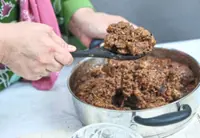
Photo: SHEELA KANAGASABAI
One of the familiar flavours I look forward to at Christmas comes from an all-time favourite recipe – gingerbread cut-out cookies. For some of us, baking and decorating these spicy gems is a tradition handed down through generations. The gingerbread we know today closely resembles the European adaptation of an ancient blend of sugar and spices.
When a senior community leader approached me to cater baked goodies for their Christmas Eve event, I decided to gift-pack gingerbread cookies. This goal inspired me to research the history behind this aromatic treat. Although the organisers were initially unenthusiastic, I became even more determined to create the most flavourful and nostalgic door gifts, reminiscent of festive spices. Giving cookies during the holidays is a heartfelt way to show you care. These thoughtful gifts bring joy and fond memories to the elderly, allowing them to celebrate the season warmly.
Few treats are as endearing and universally appealing as gingerbread cookies. Ginger, often seen as an omen of prosperity, provides health benefits through its anti-inflammatory and antioxidant properties, promoting healthy aging and combating sickness. However, as with all treats, moderation is key.
The history of gingerbread dates back to ancient Egypt around 1500 BCE, where honey cakes flavoured with raw ginger and spices were found in pharaohs’ tombs. In 992 CE, a monk named Gregory of Nicopolis introduced gingerbread to Greece and France. Early gingerbread, made from hard blocks of honey, breadcrumbs, dried ginger, and local spices, was crisp and spicy. These hard cakes were often used by Crusaders for sustenance on long voyages. In medieval Europe, bakers enhanced gingerbread dough with spices like saffron, cardamom, cloves, cinnamon, black pepper, and anise, depending on local customs. In Germany and France, gingerbread cookies were not only edible but also served as decorative and fragrant gifts.
Before gingerbread became a holiday staple, it was associated with various folklore and traditions. In some cultures, it was a tool for witches, a token of fertility, and an essential marriage charm. In English villages, unmarried women would eat gingerbread “husbands” for luck in finding a partner. Treacle, a syrup similar to molasses, replaced honey in England, giving gingerbread its softer, cake-like texture. When gingerbread arrived in America with the colonists, it became sweeter and less spiced, often incorporating maple syrup instead of treacle.
The classic story of the gingerbread man, baked by a woman and brought to life, is a popular tale. In the story, the gingerbread man escapes the oven, is chased by people and animals, and is ultimately outsmarted by a clever fox. The moral reminds us to be cautious about whom we trust. Similarly, the Brothers Grimm's tale Hansel And Gretel popularised the concept of gingerbread houses, inspiring the creation of elaborate edible houses decorated with frosting and candy.
Baking gingerbread cutouts with festive icing, gold and silver sprinkles, mini candy canes, and sanding sugars takes patience but creates a delightful holiday atmosphere. These cookies can adorn Christmas trees as garlands, greet guests as part of a fragrant wreath, or serve as cheerful treats to warm cold hands and hearts.
Today, gingerbread comes in various forms, from crispy gingersnaps and aromatic bundt cakes to yule logs and other desserts. The shaped cookies of yesteryear, often baked thin and crispy, now come in a variety of festive designs. In the 16th century, Queen Elizabeth I famously surprised her guests with gingerbread biscuits shaped in their likeness, decorated with royal icing. These specially crafted cookies became symbols of peace and love.
For many around the world, cookies symbolise the spirit of giving. In all shapes and flavours, they represent generosity, solidarity, and seasonal joy. When I think of cookies, gingerbread cookies come to mind first. Making rich, buttery ginger and spice cookies in festive shapes is a simple yet delightful tradition. Perfect for cookie exchanges, these warm, spiced treats are fun to make, decorate, and eat. Decorated with edible snowflakes and festive icing, they rarely last long after Christmas. The tradition of leaving cookies and milk for Santa continues to symbolise gratitude and the spirit of Christmas.
No other cookie unites the world in celebrating family traditions quite like gingerbread. Its connection to Christmas feels natural, and for me, gingerbread cookies hold a special place in my heart.










































